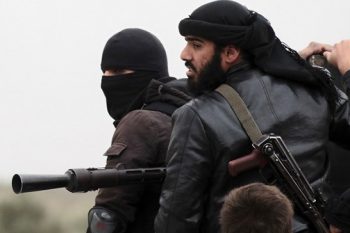 February 2014 • Analysis •
February 2014 • Analysis •
As the war in Syria began to intensify in late 2011, the exhortation to go to Syria to fight or help was seen on Islamic Internet forums and heard in mosques all over the world. Since then Syria has proved a magnet for foreign volunteer fighters from a range of countries. Though their numbers are not conclusively known, it is believed that at least 8,000 and perhaps as many as 11,000 ‘international jihadists’ are currently in Syria
Although the conflict in Syria started as an internal uprising, the ‘revolution’ currently appears to have been coopted by international players. Prominent among these are militant Sunni jihadists, in particular members of the group known as the Islamic State of Iraq and al-Sham (ISIS). Given the high profile assumed by truly Islamist groups like ISIS, outside observers commonly think of them as being the dominant forces in the conflict. This perception is trumpeted by the Syrian government, which casts itself as the last rampart in the fight against alQaeda
and its brand of violent international terrorism.
The reality on the ground, however, is more nuanced than either the Syrian government or most outsiders describe. ISIS is usually said to be well organized, well armed, and well funded. This is partially true and explains why it has managed to assume a significant role in the conflict. On the other hand, the backlash launched by previously allied militant groups against ISIS at the beginning of January 2014 is evidence that its prominence should not be conflated with leadership.
This Note intends to offer a snapshot of the engagement of foreign fighters in Syria at the end of 2013, with an emphasis on assessing ISIS’s strengths and weaknesses. In so doing, it seeks to answer the following questions: How did the foreign fighters come to ISIS? What was ISIS’s operational impact? Does the example of ISIS in Syria offer evidence about the future of transnational jihadism?
The information in this Dispatch is drawn from a series of interviews held by the author in Istanbul, Antakya, Reyhanli, Gaziantep, and Kilis from 13 to 25 September 2013. These interviews were with Syrian doctors, logisticians, journalists, lawyers, and judges, as well as non-Syrian activists (especially from the Caucasus region) involved with humanitarian organizations in the region. Key findings of the Dispatch include the following:
-
Recruiting networks outside Syria do not appear to be structured. Instead, a largely bottom-up voluntary recruitment and routing process is in place.
-
Foreign fighters in Syria are most concerned with the political context of their home countries set in a regional perspective. The special place of Bilad al-Sham (Greater Syria) in Islamic doctrine and the fight against the Syrian government’s injustices are lesser motivations.
-
ISIS’s strength should not be overestimated. While it has some comparative advantages, it does not maximize them, or they are outweighed by its weaknesses.

 February 2014 • Analysis •
February 2014 • Analysis •
